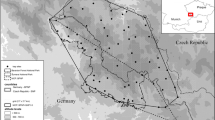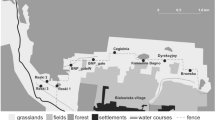Abstract
Rigorous cost-effective census methods are an essential part of managing wild animal populations, particularly if the involved species require continuous monitoring. In recent years, the range and size of the Iberian lynx (Lynx pardinus) population have increased notably as a result of conservation programs. Given this expansive scenario, monitoring Iberian lynx using camera-traps may become logistically and financially unfeasible. Here, we test whether or not scat counts are as efficient as camera-trapping in predicting lynx densities and compare the cost of these two approaches to lynx monitoring. We found a significant positive linear relationship between these two methods of assessing Iberian lynx abundance. Lynx abundance assessment by scat counting was six times less expensive than camera-trapping; there was no significant effect of the two study areas on the observed patterns (GLM F1,7 = 45.81, P < 0.001). Our study shows that scat counting is a non-invasive cost-effective method that can provide reliable assessments of Iberian lynx abundance. However, if comparisons are to be made, censuses should be carried out (a) under as nearly identical conditions as possible and (b) in the same season. A number of different factors affect scat abundance, and in order to improve counts, it would be of great interest to evaluate the potential effect of the factors that cause scat estimates to vary.

Similar content being viewed by others
References
Acevedo P, Ferreres J, Jaroso R, Durán M, Escudero MA, Marco J, Gortázar C (2010) Estimating roe deer abundance from pellet group counts in Spain: an assessment of methods suitable for Mediterranean woodlands. Ecol Indic 10(6):1226–1230
Alda F, Inogés J, Alcaraz L, Oria J, Aranda A, Doadrio I (2008) Looking for the Iberian lynx in central Spain: a needle in a haystack? Anim Conserv 1–9
Andelt W, Andelt S (1984) Diet bias in scat deposition-rate surveys of coyote density. Wildl Soc Bull 12(1):74–77
Balme GA, Hunter LTB, Slotow R (2009) Evaluating methods for counting cryptic carnivores. J Wildl Manag 73:433–441
Barne RFW (2001) How reliable are dung counts for estimating elephant numbers? Afr J Ecol 39(1):1–9
Birks J, Messenger J, Braithwaite, Davison A, Brookes R, Strachan C (2005) Are Scat Surveys a Reliable Method for Assessing Distribution and Population Status of Pine Martens?. In Martens and Fishers (Martes) in Human-Altered Environments. An International Perspective Harrison, Daniel J., Fuller, Angela K., Proulx, Gilbert (Eds.) 235–252. Springer USDA
Cavallini P, Santini S (1996) Reproduction of the red fox Vulpes vulpes in Central Italy. Ann Zool Fenn 33:267–274
Cossios ED, Madrid A, Consori JL, Fajardo U (2007) Update on the distribution of the Andean cat Oreailurus jacobita and the pampas cat Lynchailurus colocolo in Peru. Endanger Species Res 3:313–320
Farrell LE, Roman J, Sunquist ME (2000) Dietary separation of sympatric carnivores identified by molecular analysis of scats. Mol Ecol 9:1583–1590
Fernandez N, Delibes M, Palomares F (2006) Landscape evaluation in conservation: Molecular sampling and habitat modeling for the Iberian lynx. Ecol Appl 16(3):1037–1049
Garrote G, Perez de Ayala R, Pereira P, Robles F, Guzman N, García F, Iglesias MC, Hervás J, Fajardo I, Simón M, Barroso JL (2011) Estimation of the Iberian lynx (Lynx pardinus) population in the Doñana area, SW Spain, using capture-recapture analysis of camera-trapping data. Eur J Wildl Res 57:355–362
Genovesi P, Sinibaldi I, Boitani L (1996) Spacing patterns and territoriality of the stone marten. Can J Zool 75:1966–1971
Gil-Sánchez JM, Ballesteros-Duperón E, Bueno-Segura JF (2006) Feeding ecology of the Iberian lynx Lynx pardinus in eastern Sierra Morena (Southern Spain). Acta Theriol 51(1):85–90
Guzmán N, García FJ, Garrote G, Pérez de Ayala R, Iglesias C (2004) El lince ibérico (Lynx pardinus) en España y Portugal. Censo diagnóstico de sus poblaciones. Dirección General para la Biodiversidad, Madrid
Harrington LA, Andrew L, Harrington D, Macdonald DW (2008) Estimating the relative abundance of American mink Mustela vison on lowland rivers: Evaluation and comparison of two techniques. Eur J Wildl Res 54:79–87
Karanth KU (1995) Estimating tiger populations from camera-trap data using capture–recapture models. Biol Conserv 71:333–338
Lucherini M, Reppucci J, Luengos Vidal E (2009) A comparison of three methods to estimate variations in the relative abundance of mountain vizcachas (Lagidium viscania) in the high Andes ecosystems. J Neotrop Mammal 16:223–228
Mondol S, Karanth UK, Kumar AN, Gpalaswany AM, Andheria A, Ramakrishnan U (2009) Evaluation of non-invasive genetic sampling methods for stimating tiger population size. Biol Conserv 142(10):2350–2360
Norris D, Michalski F (2010) Implications of faecal removal by dung beetles for scat surveys in a fragmented landscape of the Brazilian Amazon. Oryx 44(3):455–458
Nowell C, Jackson P (1996) Wildcats, Status survey and conservation action plan. IUCN, Gland, Switzerland
Palomares F, Godoy JA, Piriz A, O’Brien SJ, Johnson WE (2002) Faecal genetic analysis to determine the presence and distribution of elusive carnivores: Design and feasibility for the Iberian lynx. Molec Ecol 11:2171–2182
Palomares F, Delibes M, Revilla E, Calzada J, Fedriani JM (2001) Spatial ecology of iberian lynx and abundance of European Rabbits in Southwestern Spain. Wildl Monogr 148:1–36
Parry GS, Forman D, Hill C (2006) Monitoring the mustelids: factors affecting the degradation of Eurasian otter (Lutra lutra L.) spraints. Poster presentation. British Ecological Society Annual Meeting, Oxford
Perez I, Geffen E, Mokady O (2006) Critically endangered Arabian leopards Panthera pardus nimr in Israel: Estimating population parameters using molecular scatology. Oryx 40:295–301
Roberts NJ (2011) Investigation into survey techniques of large mammals: Surveyor competence and camera-trapping vs. transect-sampling. Biosci Horiz 4:40–49
Ruell EW, Riley SPD, Douglas MR, Pollinger JP, Crooks KR (2009) Estimating bobcat population sizes and densities in a fragmented urban landscape using noninvasive capture-recapture sampling. J Mammal 90(1):129–135
Sarmento P, Cruz J, Monterroso P, Tarroso P, Ferreira C, Negroes N, Eira C (2009) Status survey of the critically endangered Iberian lynx Lynx pardinus in Portugal. Eur J Wildl Res 55:247–253
Smart JCR, Ward AI, White PCL (2004) Monitoring woodland deer populations in the UK: an imprecise science. Mammal Rev 34:99–114
Seber GA (1982) The estimation of animal abundance. Charles Griffin & Co, London
Silver SC, Ostro LET, Marsh LK, Maffei L, Noss AJ, Kelly MJ, Wallace RB, Gómez H, Ayala G (2004) The use of camera traps for estimating jaguar Panthera onca abundance and density using capture/recapture analysis. Oryx 38:1–7
Silveira L, Ata J, Diniz-filho JAF (2003) Camera trap, line transect census and track surveys: a comparative evaluation. Biol Conserv 114:351–355
Simón MA, Gil-Sánchez JM, Ruiz G, Garrote G, McCain E, Fernandez L, López-Parra M, Rojas E, Arenas-Rojas R, del Rey T, García-Tardío M, López G (2012) Reverse of the decline of the endangered Iberian lynx. Conserv Biol 26:731–736
Trolle M, Kéry M (2003) Estimation of ocelot density in the Pantanal using capture-recapture analysis of camera-trapping data. J Mammal 84:607–614
Acknowledgments
The study was supported by DGCONA-MIMAM project “Censo- Diagnóstico de las Poblaciones de Lince Ibérico en España”. We wish to express our gratitude to Nicolas Guzmán, Paco García, Concha Iglesias, Pablo Pereira, and Paco Robles that carried out with us the fieldwork. We also thank Organismo Autónomo de Parques Nacionales (Doñana and Lugar nuevo), Parque Natural de Doñana, Parque Natural de la Sierra de Andújar, TRAGSA, Fundación CBD-Hábitat, WWF/España, EGMASA, CMA Junta de Andalucía. We thank the anonymous reviewers for their constructive comments.
Author information
Authors and Affiliations
Corresponding author
Additional information
Communicated by C. Gortázar
Rights and permissions
About this article
Cite this article
Garrote, G., de Ayala, R.P. & Tellería, J.L. A comparison of scat counts and camera-trapping as means of assessing Iberian lynx abundance. Eur J Wildl Res 60, 885–889 (2014). https://doi.org/10.1007/s10344-014-0855-7
Received:
Revised:
Accepted:
Published:
Issue Date:
DOI: https://doi.org/10.1007/s10344-014-0855-7




